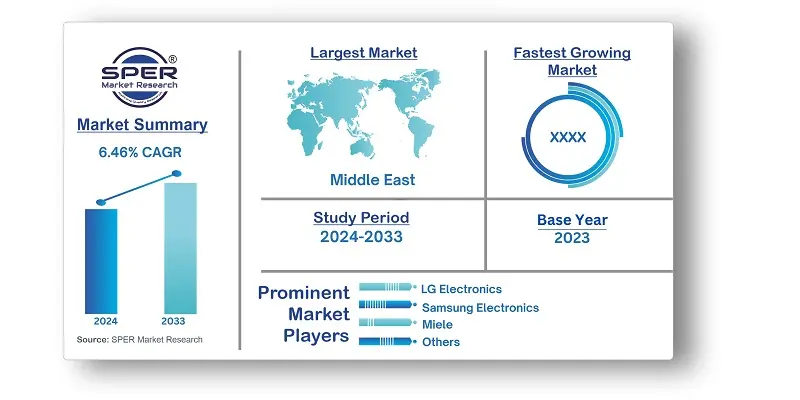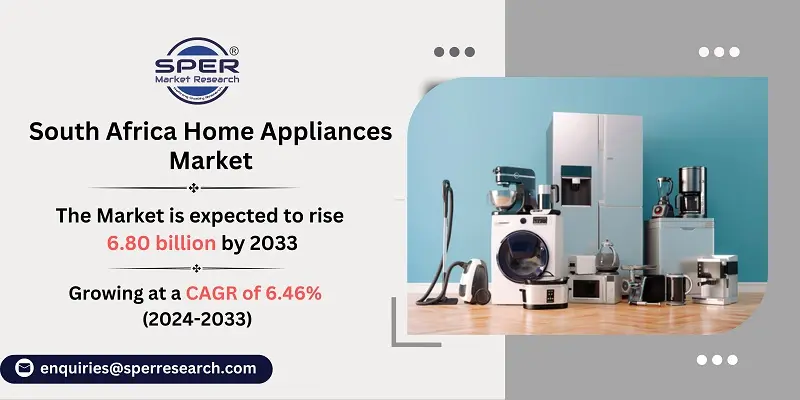
South Africa Home Appliances Market Growth, Size, Trends, Share, Revenue and Future Outlook
South Africa Home Appliances Market Size- By Product, By Small Appliances, By Distribution Channel- Regional Outlook, Competitive Strategies and Segment Forecast to 2033
| Published: Jul-2024 | Report ID: IACT24139 | Pages: 1 - 105 | Formats*: |
| Category : Information & Communications Technology | |||
- March 2023; Haier unveiled their newest range of top-load washing machines with anti-scaling technology. This series, which includes 3D rolling wash, bionic magic filter, and Haier's anti-scaling technology, is designed to satisfy the needs of modern living. The laundry experience will be quick, easy, and stress-free thanks to the equipment, which prioritize fabric care.
- March 2023; With the launch of its newest range of semi-automatic washers, Samsung debuted features like the Dual Magic Filter and Soft Closing Toughened Glass Lid. Convenience and efficiency are given priority in these additions, which improve user experience.


| Report Metric | Details |
| Market size available for years | 2020-2033 |
| Base year considered | 2023 |
| Forecast period | 2024-2033 |
| Segments covered | By Product, By Small Appliance, By Distribution Channel |
| Regions covered | Eastern Cape, Free State, Gauteng, KwaZulu-Natal, Limpopo, Mpumalanga, Northern Cape, North West, Western Cape |
| Companies Covered | AEG, Bosch, Defy, Haier Electronics Group Co. Ltd, Hisense, LG Electronics, Miele, Samsung Electronics, Smeg, Whirlpool Corporation, Others. |
- Middle-Class Families
- Young Professionals
- Urban Households
- Renovators
- First Time Buyers
- Interior Designers and Decorators
| By Product: |
|
| By Small Appliances: |
|
| By Distribution Channel: |
|
- South Africa Home Appliances Market Size (FY’2024-FY’2033)
- Overview of South Africa Home Appliances Market
- Segmentation of South Africa Home Appliances Market by Product (Refrigerators, Freezers, Dishwashers, Washing Machines, Others)
- Segmentation of South Africa Home Appliances Market by Small Appliances (Vacuum Cleaners, Iron, Toasters, Hair Dryers, Others)
- Segmentation of South Africa Home Appliances Market by Distribution Channel (Multi Brand Stores, Exclusive Stores, Online, Other Distribution Channels)
- Statistical Snap of South Africa Home Appliances Market
- Expansion Analysis of South Africa Home Appliances Market
- Problems and Obstacles in South Africa Home Appliances Market
- Competitive Landscape in the South Africa Home Appliances Market
- Impact of COVID-19 and Demonetization on South Africa Home Appliances Market
- Details on Current Investment in South Africa Home Appliances Market
- Competitive Analysis of South Africa Home Appliances Market
- Prominent Players in the South Africa Home Appliances Market
- SWOT Analysis of South Africa Home Appliances Market
- South Africa Home Appliances Market Future Outlook and Projections (FY’2024-FY’2033)
- Recommendations from Analyst
1.1. Scope of the report1.2. Market segment analysis
2.1. Research data source2.1.1. Secondary Data2.1.2. Primary Data2.1.3. SPER’s internal database2.1.4. Premium insight from KOL’s2.2. Market size estimation2.2.1. Top-down and Bottom-up approach2.3. Data triangulation
4.1. Driver, Restraint, Opportunity and Challenges analysis4.1.1. Drivers4.1.2. Restraints4.1.3. Opportunities4.1.4. Challenges4.2. COVID-19 Impacts of the South Africa Home Appliances Market.
5.1. SWOT Analysis5.1.1. Strengths5.1.2. Weaknesses5.1.3. Opportunities5.1.4. Threats5.2. PESTEL Analysis5.2.1. Political Landscape5.2.2. Economic Landscape5.2.3. Social Landscape5.2.4. Technological Landscape5.2.5. Environmental Landscape5.2.6. Legal Landscape5.3. PORTER’s Five Forces5.3.1. Bargaining power of suppliers5.3.2. Bargaining power of buyers5.3.3. Threat of Substitute5.3.4. Threat of new entrant5.3.5. Competitive rivalry5.4. Heat Map Analysis
6.1. South Africa Home Appliances Market Manufacturing Base Distribution, Sales Area, Product Type6.2. Mergers & Acquisitions, Partnerships, Product Launch, and Collaboration in South Africa Home Appliances Market
7.1. South Africa Home Appliances Market Size, Share and Forecast, By Product, 2020-20267.2. South Africa Home Appliances Market Size, Share and Forecast, By Product, 2027-20337.3. Refrigerators7.4. Freezers7.5. Dishwashers7.6. Washing Machines7.7. Others
8.1. South Africa Home Appliances Market Size, Share and Forecast, By Small Appliances, 2020-20268.2. South Africa Home Appliances Market Size, Share and Forecast, By Small Appliances, 2027-20338.3. Vacuum Cleaners8.4. Iron8.5. Toasters8.6. Hair Dryers8.7. Others
9.1. South Africa Home Appliances Market Size, Share and Forecast, By Distribution Channel, 2020-20269.2. South Africa Home Appliances Market Size, Share and Forecast, By Distribution Channel, 2027-20339.3. Multi Brand Stores9.4. Exclusive Stores9.5. Online9.6. Other Distribution Channels
10.1. South Africa Home Appliances Market Size and Market Share
11.1. South Africa Home Appliances Market Size and Market Share By Region (2020-2026)11.2. South Africa Home Appliances Market Size and Market Share By Region (2027-2033)11.3. Eastern Cape11.4. Free State11.5. Gauteng11.6. KwaZulu-Natal11.7. Limpopo11.8. Mpumalanga11.9. Northern Cape11.10. North West11.11. Western Cape
12.1. AEG12.1.1. Company details12.1.2. Financial outlook12.1.3. Product summary12.1.4. Recent developments12.2. BOSCH12.2.1. Company details12.2.2. Financial outlook12.2.3. Product summary12.2.4. Recent developments12.3. DEFY12.3.1. Company details12.3.2. Financial outlook12.3.3. Product summary12.3.4. Recent developments12.4. HAIER ELECTRONICS GROUP CO. LTD12.4.1. Company details12.4.2. Financial outlook12.4.3. Product summary12.4.4. Recent developments12.5. HISENSE12.5.1. Company details12.5.2. Financial outlook12.5.3. Product summary12.5.4. Recent developments12.6. LG ELECTRONICS12.6.1. Company details12.6.2. Financial outlook12.6.3. Product summary12.6.4. Recent developments12.7. MIELE12.7.1. Company details12.7.2. Financial outlook12.7.3. Product summary12.7.4. Recent developments12.8. SAMSUNG ELECTRONICS12.8.1. Company details12.8.2. Financial outlook12.8.3. Product summary12.8.4. Recent developments12.9. WHIRLPOOL CORPORATION12.9.1. Company details12.9.2. Financial outlook12.9.3. Product summary12.9.4. Recent developments12.10. Others
SPER Market Research’s methodology uses great emphasis on primary research to ensure that the market intelligence insights are up to date, reliable and accurate. Primary interviews are done with players involved in each phase of a supply chain to analyze the market forecasting. The secondary research method is used to help you fully understand how the future markets and the spending patterns look likes.
The report is based on in-depth qualitative and quantitative analysis of the Product Market. The quantitative analysis involves the application of various projection and sampling techniques. The qualitative analysis involves primary interviews, surveys, and vendor briefings. The data gathered as a result of these processes are validated through experts opinion. Our research methodology entails an ideal mixture of primary and secondary initiatives.



Frequently Asked Questions About This Report
PLACE AN ORDER
Year End Discount
Sample Report
Pre-Purchase Inquiry
NEED CUSTOMIZATION?
Request CustomizationCALL OR EMAIL US
100% Secure Payment






Related Reports
Our Global Clients
Our data-driven insights have influenced the strategy of 200+ reputed companies across the globe.




















